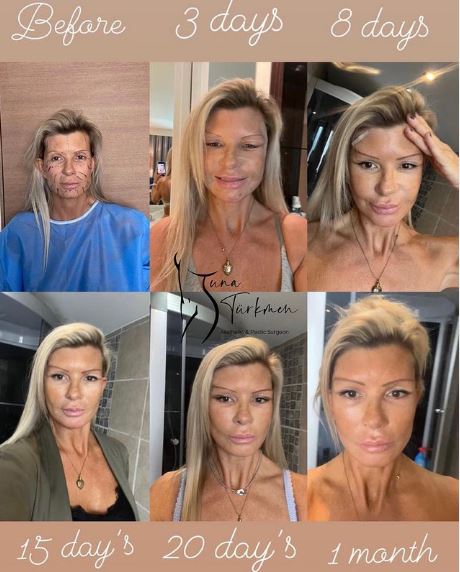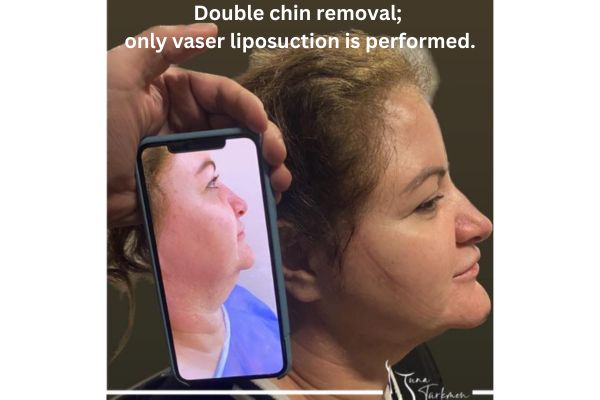What is facelift technique?
Face lifting is a surgical method that corrects sagging and wrinkles caused by aging and creates younger and more prominent facial features.
In the medical field, the procedure known as a rhytidectomy is a facelift. It should be stated that the stretching and hanging technique is used during the procedure to remove sagging and other issues, particularly wrinkles on the face. The goal of facial rejuvenation procedures is to solve every issue that arises with ageing on the face. Wrinkles, spots, and sagging skin develop on the skin, and although it varies based on inherited and environmental factors, we can state that a certain percentage varies depending on the effect of ageing for each individual. We may state that unfavourable circumstances on the face arise from a variety of factors, including a sedentary lifestyle, alcohol and tobacco use, stress, and particularly unfavourable living arrangements.
With aging, there is a loss of elasticity in the facial skin; As a result, sagging and contour irregularities occur especially in the jaw line and mid-face area. The aging of the face is not limited to this; Baggage in the lower eyelids, drooping of the upper eyelids, drooping of the eyebrows, vertical wrinkles between the eyebrows and horizontal wrinkles in the forehead are other signs of aging.

With this surgery, sagging especially in the face and neck area is removed and a more prominent chin and face appearance is created. Excess sagging skin is removed, subcutaneous tissues are collected or suspended by lifting. Facelift can be combined with other surgical or non-surgical methods if necessary.
Although the surgery is often performed under general anesthesia, it can also be performed under local anesthesia under sedation support, in cases where the patient has a condition that may prevent general anesthesia or is not preferred by the patient.

After the surgery, as after every surgery, there is a general swelling and bruising in the face and neck area. This appearance will decrease significantly within 1-2 weeks. There may be some feeling of tension on the face. This situation will disappear in a few days. The patient can return to work within 1 week-10 days. The healing of the face continues in this process and the face starts to take its final shape after about 2 months. This process continues for 6 months - 1 year, less clearly.
What is Bichectomy surgery?
Bichectomy is a surgical procedure that involves removing buccal fat pads and narrowing the lower face.In the below surgery, we achieved more prominent cheeks, defined jaws, and a slimmer lower face. It can be done under local anesthesia, and it takes 15 minutes.
What causes facial sagging?
In general, the face is the part of the body that shows the earliest signs of aging. In addition to aging, the effects of sunlight and gravity also cause changes in the face. When the tension caused by muscle contractions and the amount of fat tissue under the skin decreases with advancing age, sagging occurs, especially around the chin and neck, and the skin generally becomes dry. When the skin thickens and begins to lose its elasticity, lines, wrinkles and sagging occur. These symptoms appear faster as exposure to sunlight increases.
What is the best age for a woman to get a facelift?
Although facelift is sometimes performed at a young age, good results can be achieved by applying it to patients in their 50s and 60s, starting from the mid-40s, when the signs of aging begin to appear. Wrinkles, lines and skin sagging that appear as you get older make you a suitable candidate for facelift surgery.
Temporal lift surgery

Temporal lift surgery is a type of aesthetic surgery used to remove wrinkles and sagging that develops in the temple area as people age. It is done by making incisions along the hairline and then stretching the skin and muscles in the temple region upward and outward.
Temporal lift surgery helps lift the cheek, brow, and lateral canthal area.
What is the most effective non-surgical facelift?
Face lift can also be performed with face lift tapes and other non-surgical methods. Among these methods; liquid facelift, endopeel, spider webs face lift, facelift strap, thread facelift, focus ultrasound facelift, thermage facelift and needle facelift treatments. There are also botox and filler treatments for wrinkles. However, permanent results should not be expected from these methods. The results of these facelift procedures generally last between 6 and 1 year. If a surgical facelift will not be performed at the end of this period, the treatments in question should be performed again.
Face and Neck Lift
What is neck lift surgery?
Neck lift surgery is a significant treatment, particularly for those who are older. Ageing causes both facial and neck skin to droop. As a result, the chin-neck angle vanishes. People who gain and lose weight frequently exhibit this. Furthermore, in those with a small lower jaw, the skin beneath the neck becomes looser at younger ages. Overweight individuals face the same issue. Fat is added to the skin in the jowl, or area beneath the chin, in those with these kinds of issues.
Women over the age of 55 often undergo neck lift surgery. For women of this age, the face and neck show obvious indications of ageing. Furthermore, we can say that the symptoms include deep furrows around the eyes and forehead, ringing beneath the eyes, lines that form a smile and are noticeable from a distance, sagging in the lower part of the mouth, squaring of the jaw corners due to excess skin, formation of vertical bands on the neck, and formation of a pouch-like area of skin under the chin.
For patients who complain of such discoveries, simultaneous treatments for face, eyelid, and neck lifts are therefore carried out. To put it another way, the goals are both physical attractiveness and a better lifestyle.

Deep Neck Lift
A deep neck lift is a surgical technique used to treat muscular laxity, drooping skin, and excess fat with the goal of revitalising the lower face and neck area. In contrast to conventional neck lifts, which emphasise the surface layers of the neck, a deep neck lift addresses the deeper structures, such as the tissue beneath the platysma muscle.
Incisions are usually done behind the ears and occasionally beneath the chin during a thorough neck lift. The surgeon can reach the neck's underlying muscles and tissues through these incisions, and they can then tighten and realign them as necessary. Liposuction is a procedure that can be used to remove excess fat, and skin that is hanging or loose is cut off.
People with noticeable muscle bands in the neck region or considerable neck laxity frequently seek this surgery. Compared to non-surgical procedures or conventional neck lifts, it can produce more noticeable and durable effects.
There are dangers associated with any surgical operation, so it's important to speak with a licenced plastic surgeon to find out if a deep neck lift is the best course of action for reaching your desired cosmetic outcomes.
Forehead Reduction Surgery
Forehead reduction surgery, also known as hairline lowering surgery, is a cosmetic procedure designed to reduce the height of the forehead by advancing the hairline. This is typically achieved by removing a strip of skin from the upper forehead and pulling the hairline down to a lower position. The goal is to create a more proportionate and aesthetically pleasing facial appearance. This surgery can be particularly beneficial for individuals with a naturally high hairline or those experiencing forehead elongation due to hair loss.
Key aspects of forehead reduction surgery include:
- Consultation and Planning:
- Surgical Procedure:
- Recovery:
- Risks and Considerations:
The surgeon assesses the patient's facial proportions, hairline, and scalp flexibility to determine the best approach.
Under anesthesia, an incision is made along the natural hairline. A strip of forehead skin is removed, and the hair-bearing scalp is advanced and sutured in place.
Patients can expect some swelling and bruising post-surgery, with most returning to normal activities within a week or two. It usually takes several months to get full healing and desired outcomes.
Potential risks include scarring, infection, and changes in scalp sensation. Choosing an experienced surgeon can minimize these risks and ensure optimal outcomes.
Forehead reduction surgery can significantly enhance facial balance and boost self-confidence for those unhappy with their forehead size.

What is Chin Enlargement Surgery?
Specialists in plastic, reconstructive, and aesthetic surgery are able to provide people with the opportunity to eliminate their chin-related issues with this procedure. Put differently, it concerns a procedure carried out to give people's chins the necessary shape adjustments. Generally, plastic surgeons do this procedure. The chin can be shaped after undergoing this procedure. Furthermore, the face has a balanced aesthetic. Enhancement of the chinbone and removal of functional abnormalities in the chin are achievable through aesthetic chin augmentation procedures. In the process, the chinbone receives an implant. The intended alteration to the chin bones is thus accomplished.

